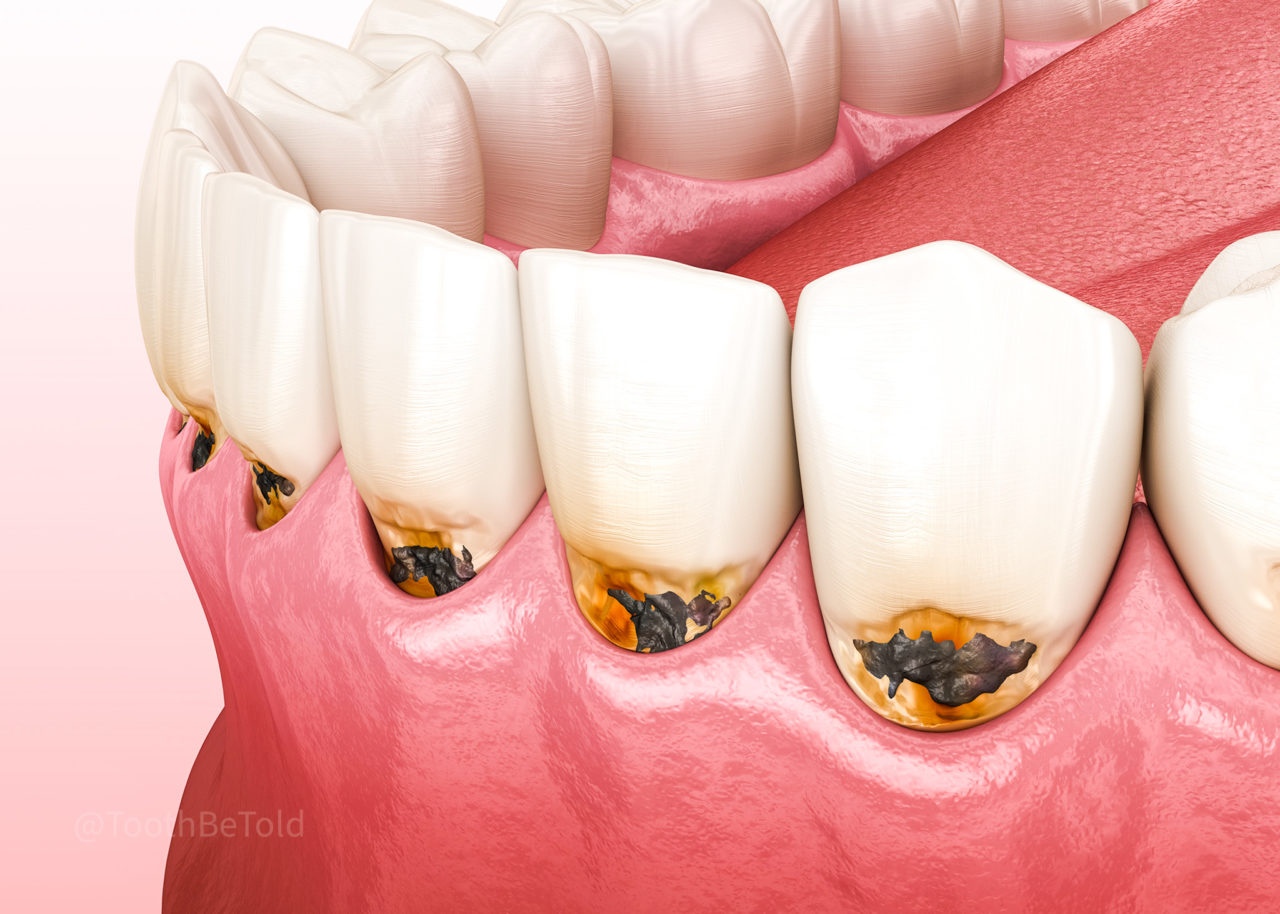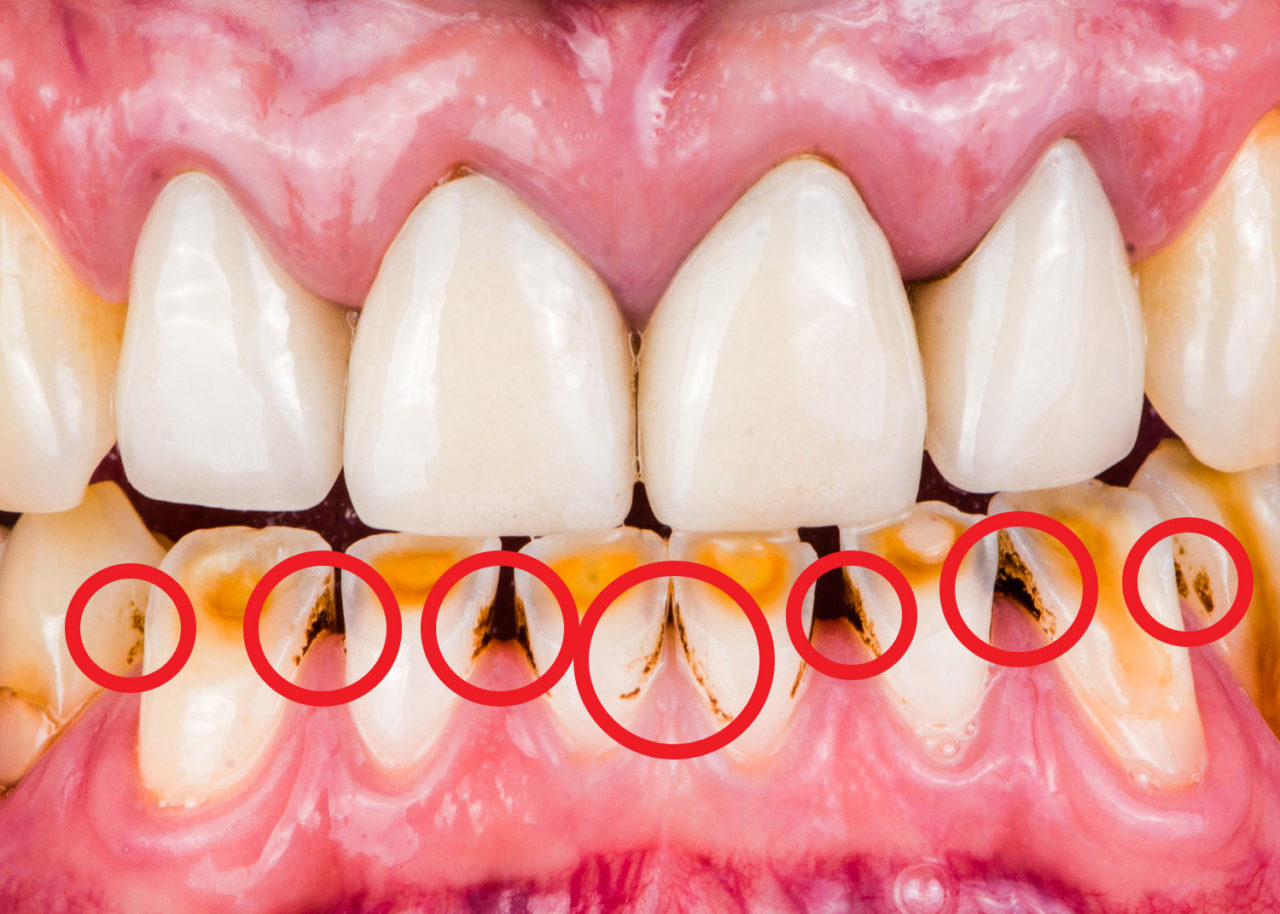With more and more emphasis on the aesthetics of our mouths and the rise in cosmetic dentistry, more and more people are paying attention to how their teeth look. I’ve had more patients asking me how to remove the black line on their crown because it’s aesthetically not pleasing.
A dental crown will need to be replaced to eliminate the black line. The black line is caused by exposed metal under the porcelain. Technology and porcelain durability have improved in recent years, allowing anterior crowns to be made solely of porcelain, so there is no possibility of a black line.

Below I dive into more detail about black lines on crowns, some warnings about replacing crowns that you need to know before making a decision, and other causes of black lines around the crown.
Why do dental crowns have a black line?
Dental crowns can be made out of different materials. A type of crown called a PFM (porcelain fused to metal) is constructed with a darker metal underneath to form a strong base, with porcelain overlaid on top to make it look like a tooth.
These crowns were designed to provide maximum strength and durability and maintain aesthetics with white porcelain. Because the porcelain is fused to the metal, the crown appears very opaque, which is not how natural teeth look.
Teeth are naturally translucent; when PFM crowns are adjacent to natural teeth, the difference in appearance is evident.
However, the issue with a porcelain fused to metal crown is that a small amount of the metal will extend farther out than the porcelain to allow for the best fit. The extension of metal allows the crown to be thinner at the margin where it meets the tooth.
The exposed metal is usually hidden underneath the gum line, so when people smile or speak, the black line of metal is hidden.
Over time as we age, gum disease and receding gums can eventually cause the crown’s metal to be in full view. So every time the entire tooth is exposed through smiling, laughing or talking, the black line is visible.
Read now: Receding Gums? Best Electric Toothbrush and Head to Use!
I have had patients tell me that they no longer want to smile or they are embarrassed to talk because their black line on their crown will show. I find this so unfortunate becuase it is impacting their self confidence.
The evolution of dental crowns; no more black line
As I previously mentioned, dental crowns have evolved over recent years. The porcelain used now for crowns at the front of the mouth is fabricated without metal because porcelain has become much more durable and long-lasting on its own than it used to be.
Newer technology has allowed crowns to be fabricated in the dental office so that they can be colour matched and stained (painted) to match adjacent teeth and provide top-tier aesthetics while you have a crown fitted in the dental office.
Some dental offices will still send the crowns to a dental lab to be fabricated and may require you to go to the lab so they can colour match and stain it with you in the chair to get an accurate match.
It is incredible how far we have come in cosmetic dentistry, and now when crowns are correctly made, they can be indistinguishable from natural teeth!
How to get rid of the black line on a dental crown
Dentistry has come a long way, and the materials used to make dental crowns have evolved.
To get rid of the black line on a dental crown, the entire crown will need to be replaced with a material that does not have metal. Full porcelain crowns contain no metal and have a similar sheen to the natural tooth structure. Because of the qualities of porcelain, it is most often chosen to construct dental crowns.
Important information you need to know;
I wouldn’t rush to replace a dental crown unless necessary because every time work is done on a tooth, there is a chance it could irritate the nerve and cause it to die, requiring a root canal.
Dental crowns can only be replaced so many times before the tooth becomes unrestorable without more drastic measures including root canal treatment and surgery.
There is only so much tooth structure that can be removed before it is not enough for the dental crown to adhere to.
If there is not enough tooth structure to support the crown, a surgery called crown lengthening will need to be performed. Crown lengthening surgery is when they surgically remove some of the bone supporting the tooth to allow more vertical dimension for the crown to be seated on.
Read now: Can Teeth Veneers Be Whitened? Hygienist Explains!
Is it bad to have a black line around a dental crown?
There is no concern with exposed metal on a dental crown as long as a complete seal between the crown and tooth is present. The black line is an aesthetic issue only.
Having a complete seal is imperative to prevent irreversible damage to the tooth. A void in the seal will allow bacteria to enter underneath the crown where a toothbrush and floss cannot reach, increasing the risk for decay.
If a gap between the crown and the tooth or decay is forming, the crown will most likely need to be replaced.
Just be careful of dental professionals telling you that you need to replace the crown just for aesthetic reasons. You can ask them if there is a complete seal around the dental crown or if you are at risk for decay. I have seen too many times dental professionals trying so hard to recommend treatment solely based on aesthetics not function.
But sometimes, a black line can be mistaken for other issues with the teeth that need to be addressed, which I go over below.
Other causes of black lines around dental crowns
Having a dental professional inspect the crown is crucial to diagnose the black line’s cause accurately. Other causes of a black line can be easily mistaken for metal and can cause irreversible damage to the tooth.
Other causes of black lines around dental crowns include;
- tooth decay
- poorly fitting crown
- staining
Tooth decay under or around the crown
Tooth decay can occur on any natural tooth surface, including around crowns.
It is a common misconception that the crown will prevent decay, and I have had many surprised patients in my dental chair when I fully explain how decay forms around crowns. I often get the response, “I thought I couldn’t get a cavity because there is a crown on the tooth.”
Bacteria are microscopic and love to hang out in any crevice, nook, and cranny they can find. The edges on dental restorations are the perfect home for the bacteria, and sometimes they can be more difficult to clean with brushing and flossing.
Maintaining regular dental hygiene appointments is important so we can catch things early but also at home; prevention is key. Flossing and brushing play important roles in preventing decay.
Read now: What Happens if You Never Floss? Dental Hygienist Explains!
When tooth decay occurs, and a cavity forms, the tooth surface becomes soft and can begin to absorb minerals from our diet, as well as pigments that can stain the teeth making the tooth appear darker.
This darkened tooth surface can appear around the margins of a crown and cause a black line.
Poorly fitting crown
If a crown poorly fits, there could be a gap, or it could be bulky and cause a shadow above the crown in certain lights.
A poorly fitting crown can increase the risk of tooth decay, so it should be addressed by a dental professional.

Tooth staining
Tooth stain occurs when the teeth come in contact with pigment from our food and drink, and smoking.
There are two types of stains; intrinsic and extrinsic.
Instrinsic stain is IN the tooth and embedded withing the tooth structure.
Extrinsic stain is on the EXTERIOR surface of the tooth.
The treatment plan will differ depending on the type of stain.
The intrinsic stain will have to be chemically removed from the teeth by “bleaching” them with professional-grade teeth whitening with hydrogen or carbamide peroxide.
No whitening toothpaste or light gimmick will whiten the tooth. Please don’t fall for misleading marketing.
Extrinsic stains can be removed by having a dental cleaning as the special tools we use will take off the stain in the safest way.
Again, having a thorough assessment is essential to have proper treatment. If you get bad vibes or are unsure about what is recommended, I always recommend having a second opinion.
I hope this information has helped you!
Have a great day,
Holly 🙂
